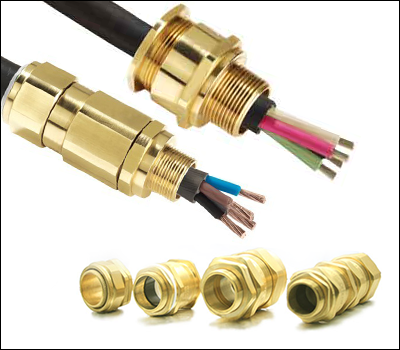Cables are ubiquitous in that they find application across a range of industries ranging from electrical to instrumentation and telecommunication. Cables along with other components used in electrical installations like cable glands, are not only manufactured to meet different industry standards but are also required to conform to a host of regional, national and international standards. This is especially true in the case of cables and cable glands used in and around hazardous areas which are also required to conform to ATEX and IEC guidelines to ensure safety of people and property working in hazardous areas.
The process of processing, manufacturing, storage or transport of combustible substances in many applications and industries leads to the production and discharge of vapors, gases and or mist into the surrounding atmosphere, many others cause the release of flammable dust into the environment. When these combustible gases, vapors or dust mix with the oxygen already present in the atmosphere, an explosive environment is created with the potential to cause an explosion in case of any kind of ignition. The possibility of such explosions is a definite possibility in industries like petrochemicals where natural gas and crude oil are extensively used and transported. In another industry, which involves working extensively with hazardous substances is the mining industry. The potential for substantive damage to both people and property working in these environments is high which is why cable glands are such a necessary component of equipments used in these industries.
There are three things required for an explosion to occur,
- The presence of a combustible substance in the form of mist, gas or vapor
- Sufficient level of oxygen in the ambient air
- Igniting source in the form of a spark or a heat source
Any kind of combustible substance can cause an explosion when it mixes with the oxygen present in the surrounding air.
The risk of damage to people and property is further enhanced if a fault develops in electrical or even electronic equipment installed in an area categorized as hazardous industrial area. The presence of high levels of flammable gases in the ambient atmosphere in a hazardous area increases the risk of the sparks or rise in heat caused by the fault to cause the flammable gases to ignite leading to a disastrous explosion. It is to prevent such an eventuality that flameproof cable glands are manufactured and used in all equipments for use in hazardous areas.
Why use Flameproof Cable Glands
The Flameproof Cable gland is a hazardous area technology generally used for enclosing heavy duty pumps and motors, luminaries and other high power consuming control units. In this technique cable glands are used to ensure the explosion is contained within the equipment enclosure itself by completely eradicating or minimizing any gaps that connect equipment cables to the outside world. In this technique cable wiring is made to enter the equipment enclosure only with the protective sealing of flame proof cable glands. This ensures that there are no flamepaths left open for any internal explosion occurring due to equipment fault to cause an even bigger explosion to occur by mixing with the potentially flammable gas present in the air.
A flameproof cable gland also referred to as a barrier gland consists of a sealing chamber through which individually insulated cable conductors are passed to form a barrier around the conductor. The purpose of creating a barrier seal around the conductor is twofold. Firstly, it prevents the escape of gas from the cable equipment to the outside air. Secondly, it acts as a barrier to prevent any spark or flame caused by an explosion within the equipment from escaping outside, thus protecting the explosion protection integrity of the surrounding apparatus and preventing any further damage from happening. Application of flameproof cable glands in equipment cables used in hazardous industrial areas requires both world class manufacturing capabilities as well as high level of technical proficiency.
High Quality and Precision Cable Glands
When it is practically not feasible to keep electrical equipment out of hazardous areas, it becomes imperative to provide a higher level of protection through the use of cable glands. The danger of working with electrical equipment is that they very often contain incendiary devices that can cause arcing and sparking devices, some of them may even contain flammable mixtures that could permeate the equipment enclosure. In such cases even a small equipment fault can generate heat and spark enough to cause an explosion. While it is possible to contain such an explosion in a normal industrial setting, the dangers get magnified in hazardous areas where flammable substances present in the atmosphere can transform a small spark into a major explosion. Cable glands are designed to ensure the explosion is contained within the equipment enclosure and prevent the transfer of any form of energy to escape from the enclosure and mix with the ambient inflammable air.
BICC components Limited (BICC) manufactures and distributes a wide range of Cable Connectors, Cable Cleats and certified flameproof Cable Glands to save the faulty equipment from the explosion, which designed, engineered and rigorously tested to withstand explosion in real world environments. To know more, visit https://www.bicccomponents.uk.com/. You can also visit https://www.bicccomponents.uk.com/contact-form/ to solve your queries or get a quote or drop an email to info@bicccomponents.uk.com.
 SUBSCRIBE TO OUR BLOG
SUBSCRIBE TO OUR BLOG
